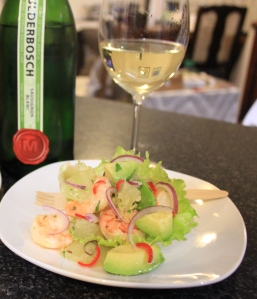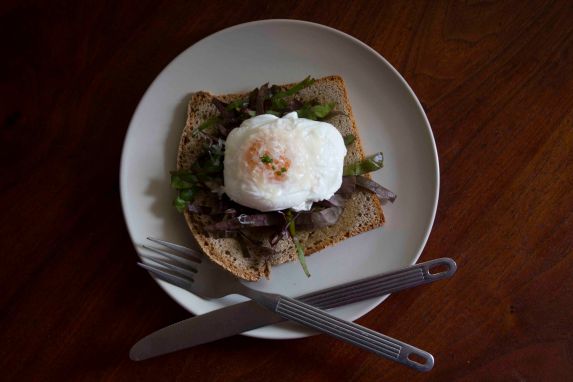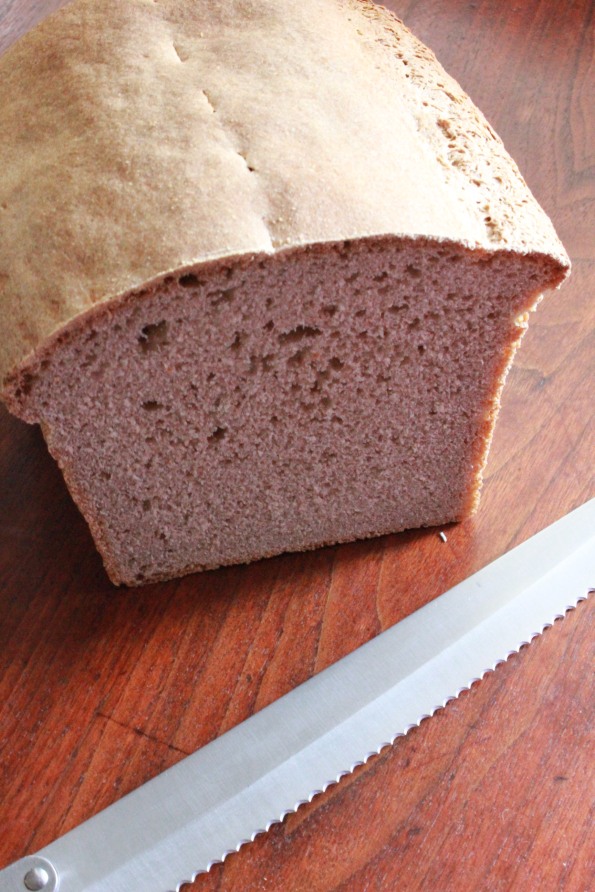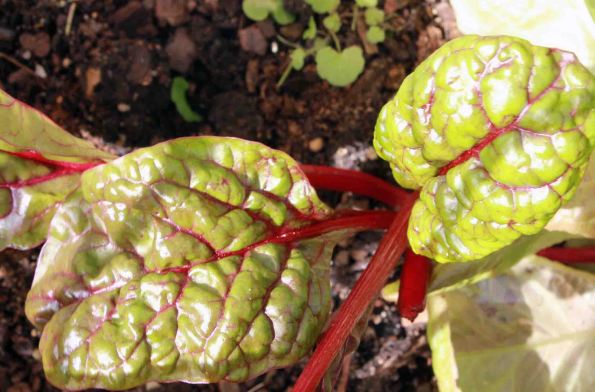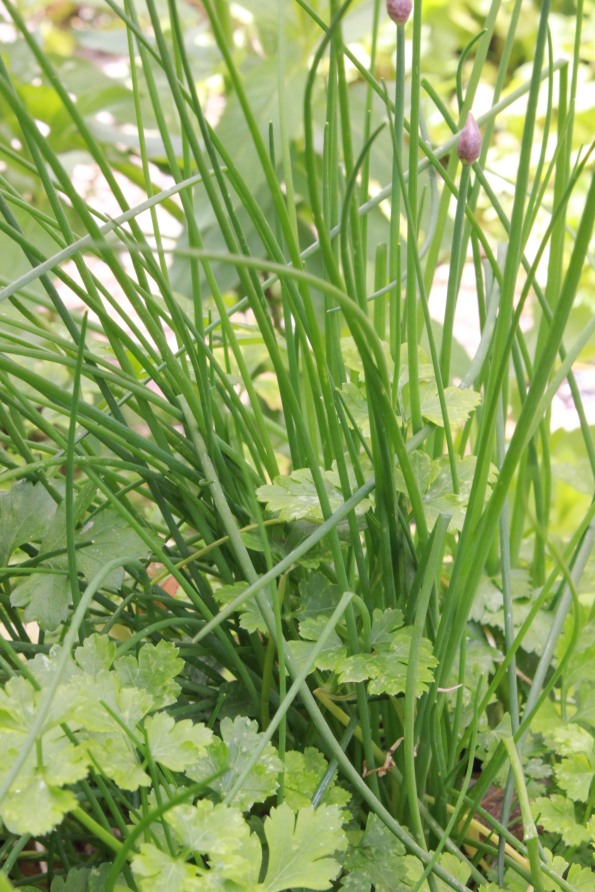Archive
Avocado Ice Cream with Strawberry Fans, Balsamic Glaze and Black Pepper
| Preparation Time: 45 minutes | Cooking Time: 0 minutes | Yield: Lots! |
 Avocado pears have always had a special place in my culinary heart, because my late mum loved them with an abiding passion. When we lived in Durban, they were of course freely available, as they grow there virtually like a weed. A short distance from our home in Westville, which was perched on the edge of a wooded valley, was a grove of avocado pear trees that were originally planted by an Indian farmer who was moved off his land during the apartheid years when the Group Areas Act was enforced. Although his farming dreams were shattered, his avocado pear trees prospered, and perhaps still stand in silent tribute to his efforts of all those years ago. Whenever Mum wanted some avocado pears, I was dispatched to go on a picking expedition. Upon my return, with the treasure trove of plump, ripe avos, she would slice one in half, remove the pip, and eat it straight out of the skin, seasoned with salt and pepper and a sprinkling of balsamic vinegar.
Avocado pears have always had a special place in my culinary heart, because my late mum loved them with an abiding passion. When we lived in Durban, they were of course freely available, as they grow there virtually like a weed. A short distance from our home in Westville, which was perched on the edge of a wooded valley, was a grove of avocado pear trees that were originally planted by an Indian farmer who was moved off his land during the apartheid years when the Group Areas Act was enforced. Although his farming dreams were shattered, his avocado pear trees prospered, and perhaps still stand in silent tribute to his efforts of all those years ago. Whenever Mum wanted some avocado pears, I was dispatched to go on a picking expedition. Upon my return, with the treasure trove of plump, ripe avos, she would slice one in half, remove the pip, and eat it straight out of the skin, seasoned with salt and pepper and a sprinkling of balsamic vinegar.
An invitation to create recipes for the Afrikado Blogger Challenge, an initiative by major avocado producer ZZ2 to encourage innovation in the use of avocados in the kitchen, prodded me into coming up with something really different. I’d done the usual before: guacamole, salads and even cold avocado soup (another of Mum’s favourites), so I decided to make ice cream for the first time.
I have no ice cream machine, and quite frankly, it’s not necessary if you devote a little time and elbow grease to the undertaking. The main thing to do, is to break down the ice crystals that form when you freeze the ice cream, and you do that by whipping it briskly and fairly frequently as it sets.
It is neither sweet nor savoury: it just tastes of avocado pear, which the salt and pepper help to emphasise, so it lends itself to a variety of uses. I’ve made a dessert this time around, but it could easily be plated with a savoury item to make a starter.
Ingredients, selection and preparation
5 ripe medium sized fully ripe avocado pears
250 ml double cream: you can use ordinary cream, but it lacks texture somewhat
5 tbsp honey
4 tbsp lemon juice
1 ml black pepper: very finely ground
2 ml salt
250g fresh strawberries
Balsamic glaze: you can make your own, but it is easier to buy it.
Freshly ground black pepper
Method
Boil a kettle of water, and pour over the avocado pears in a large bowl, leaving to stand for a minute. Drain and plunge into cold water. This will ensure that the avo flesh does not discolour for up to six hours, a tip I gleaned from Erica Platter’s cookbook, “East Coast Tables” while doing my research.
Halve and scoop out all the avodaco flesh. Remove any discoloured spots, and place in a, large freezer proof mixing bowl. Mash until completely smooth.
Add the honey, cream, lemon juice, pepper and salt.
Whip briskly until homogenised and completely smooth.
Cover the surface of the mixture with a sheet of cling film, and place in v the deep freeze until it starts to set, about 30 to 45 minutes. Remove from the freezer and whip briskly to break up the ice crystals. Cover and return to the deep freeze.
Repeat this process every half hour or so, until it thickness to the point where it is set.
Remove from the deep freeze and allow it to soften slightly before serving.
Serve two scoops of ice cream with a trio of strawberry fans garnished with balsamic glaze, and sprinkling of freshly ground black pepper. Enjoy!
Avocado, prawn and shaddock salad
| Preparation Time: 20 minutes | Cooking Time: 10 minutes | Yield: 4 |
You’re probably wondering what a shaddock is, and well you might. A visit to Danie Truter’s farm Daniels Hoogte on top of Aurora Mountain a few weeks back, introduced me to this interesting fruit. Known by some as pamplemousse (French for grapefruit), it is an enormous citrus fruit with a really thick pith.
It tastes something like a cross between an orange, a lemon and a grapefruit, and is much lie a white grapefruit in colour. We brought one home with us (you may well have seen it in last week’s recipe photo, behind the wine glass), and pondered how to put it to good use.
It came up for discussion at a night out at the Lanzerac Hotel two weekends back, with Giggling Gourmet Jenny Morris, who suggested some sort of a salad with prawns, and eventually Mrs M and I ended up with this delightful starter salad, and although it is winter, the current balmy weather makes it quite acceptable.
If you can’t get hold of a shaddock, a large grapefruit, either white or ruby will do just as well.
But it is the avocado pear that really finishes the salad off beautifully, with its velvety texture, and unctuous voluptuousness.
The wine match was also a no-brainer. A visit to the stylish Mulderbosch Tasting Room for a lunch of pizza (excellent thin crust, lovely toppings, well worth a visit if you’ve not been there) and their delightful Rosè, resulted in us laying in a small stock of wine, one of which is the lovely tropical style Suvignon Blanc.
Ingredients, selection and preparation
1 avocado pear: peeled and cubed, but at the very last minute to prevent it from going brown.
1 cup (250 ml) shaddock segments: cut the segments out of the fruit with a sharp paring knife, excluding the skin that surrounds the segments.
200g prawns: deveined, shelled and beheaded.
Canola oil: for frying.
1 red chilli: deseeded and finely sliced.
½ small red onion: peeled and finely sliced.
A few mints leaves: very finely sliced.
½ tsp cumin seeds: toasted in a dry pan until the aromas are released.
4 lettuce leaves: ideally from a medium sized lettuce, which will give you a nice cup shape to contain each salad portion.
(Dressing)
1/3 cup (85ml) shaddock juice: squeezed from what you have left over, after you’ve cut out the shaddock segments.
1 clove garlic: crushed.
½ tsp sugar
½ tsp of fish sauce
½ tsp sesame oil
Method
Heat a small wok until it begins to smoke. Add a tbsp. or two of canola oil, swill it around the wok, and flash fry the prawns until they colour and become opaque, in small batches. Set aside to cool.
Combine the salad ingredients and divide between the four salad leaf cups. Combine the dressing ingredients in a small bottle and shake well to emulsify, until the sugar has dissolved.
Anoint the salad portions with the dressing, and garnish with the sliced mint.
Wine match
The 2012 Mulderbosch Sauvignon Blanc worked particularly well with this salad. A lovely pale straw, shot through with a green tinge, it is fresh and tropical on the nose, with citrus lime whiffs.
The palate is all about taught mouth-watering acidity, bright fresh fruit flavours, a mineral edge and persistence. A great drop.
Avocado soup
| Preparation Time: 60 minutes | Cooking Time: 15 minutes | Yield: 4-6 |
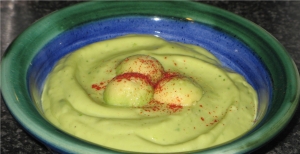 Wedding anniversaries being what they are in our household, the choice is often eat out, but considering the current state of the world’s financial systems, prudence dictated eat in last week, when our 32nd wedding anniversary rolled around, which was significant enough to warrant a three course dinner complete with bubbly.
Wedding anniversaries being what they are in our household, the choice is often eat out, but considering the current state of the world’s financial systems, prudence dictated eat in last week, when our 32nd wedding anniversary rolled around, which was significant enough to warrant a three course dinner complete with bubbly.
The main course was crispy roast duck with watercress mash and warm beetroot salad, and the dessert was a devastating crème caramel.
After much thought, and considering the Afrikado Challenge, I realised that something which my dear old late mum used to make, would be ideal: cold avocado soup.
I have so many wonderful memoriess of the elegant dinner parties my mum used to host when the family lived in Durban. Anything from three to five courses, and anything from four to twelve guests, every single course prepared with meticulous attention to detail by mum, and a table setting that would have put the Royal Hotel to shame, complete with silver plate. One of the many dishes I remember enjoying was her cold avocado soup, and considering that summer has arrived, this is what we settled on.
According to mum, the original recipe comes from one of Lynn Bedford-Hall’s books, but I had to make a couple of changes, because the first version didn’t quite work out right.
Ingredient Selection and Preparation
2 medium or 3 small avocado pears: they must be blemish free and ripe. Leave them until the very last, because if you peel them too early, the pulp will start to oxidise. When you do peel them, check very carefully for any brown spots, and excise them carefully. Mash well with a metal fork.
3tsp lemon juice
25ml chopped parsley
2 spring onions: finely chopped.
30g butter
40g flour
400ml chicken stock: if you use stock powder, be sure to strain the stock before you use it.
400ml milk: heat it to just below boiling before you use it.
Salt and pepper to taste
Paprika to garnish
Avocado balls to garnish: I gouged them out of another avocado pear, using a melon scoop.
Method
Make your chicken stock and heat the milk.
Melt the butter in a medium saucepan and add the flour bit by bit, stirring in with a balloon whisk until all the flour is integrated into the butter.
Remove from the heat, and add the chicken stock followed by the milk, stirring all the time with a balloon whisk. Be sure that there are no lumps.
Return to the heat, and cook for about three minutes or until the sauce is smooth and thickened nicely. Stir constantly to prevent sticking.
Season the sauce to taste with salt and pepper.
Remove from the heat, and pour into a glass mixing jug large enough to accommodate the white sauce as well the avocado pulp. Place a sheet of cling wrap on top of, actually touching the surface of the white sauce, to prevent a skin from forming while it cools.
Set aside to cool to room temperature. This is very important, because if you add the avocado pear pulp to white hot sauce, it will oxidise and turn brown. I know this because this is precisely what happened with the first batch I made!
Once the white sauce has cooled completely, blanch the avocado pears in boiling water for a minute, then peel and mash them. Add to the white sauce, together with the 3tsp of lemon juice, the parsley and spring onion.
Puree the mixture in a blender jug, or with a stab blender.
Divide between four or six bowls, and garnish each with three or four avocado balls and a sprinkling of paprika.
Enjoy!
Stanford University Organic Study: Is organic REALLY no healthier?
It sure is lovely to be right, isn’t it? Three Michelin star British chef Marco Pierre-White, makes smug look humble in his recent gloating rant over the findings of Stanford University in a comprehensive study of the nutritional value of organic versus conventionally grown produce. The study, a meta-analysis of some 200 research papers, found that there is no nutritional benefit in consuming organic produce instead of conventionally farmed produce.

Organically grown spinach. It may have the odd blemish, but it’s a damn side healthier in my view than the “conventionally” grown stuff.
Since the publication of the study however, it has been criticised in a number of areas. Susan Clark, executive director of the Columbia Foundation, a non-profit organisation dedicated to the furtherance of public welfare across a broad front, was quoted in an article on The New York Times web site: “The researchers started with a narrow set of assumptions and arrived at entirely predictable conclusions. Stanford should be ashamed of the lack of expertise about food and farming among the researchers, a low level of academic rigor in the study, its biased conclusions, and lack of transparency about the industry ties of the major researchers on the study. Normally we busy people would simply ignore another useless academic study, but this study was so aggressively spun by the PR masters that it requires a response.”
It turns out as she notes, that more than one of the researchers had interesting links to Big Tobacco, having both worked for the powerful Tobacco Institute which sought to “prove” that tobacco consumption posed no health risks.
The aforesaid notwithstanding organic (and biodynamic for that matter) foodstuffs are more expensive. If the Stanford study was in fact accurate this would mean that everybody, not just the less well-heeled in our skewed society, could safely disregard organic produce in future.
But you would be wrong in that notion, because nutritional value aside, it is arguably healthier because of the lack of pesticides, herbicides, and organo-phosphate fertilisers in fruit and vegetables, and the growth hormones and antibiotics in animal products. And let’s not forget the inhumane treatment that is inherent in factory farmed animal products.
What I find most odd is the use of the term “conventional” to describe contemporary factory style farming, when in fact for the greater period of our agricultural history, organic was conventional. When man evolved from hunter-gatherer into a pastoralist and a cultivator of crops, pesticides, herbicides, and organo-phosphate fertilisers did not exist, nor for that matter did growth hormones and antibiotics.
As the world’s population grew, the need to produce more food increased apace, which is the justification for contemporary factory farming. But at what cost?
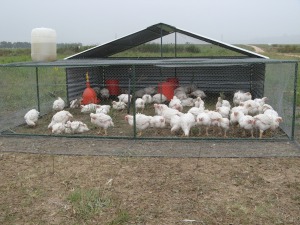
Free range chickens in their pasture pen on Spier Biodynamic Farm. Plenty of room in the cage, access to the open air, but with shelter from the elements. They get fed a small quantity of grain each day, and graze pasture if they get hungry. The cages are moved to a new patch of pasture each day. The birds are slaughtered on the farm, in a certified humane slaughtering facility.
If you take a look around you at so much of the farm land in the Boland, you’ll see how it is farmed. Fumigated soil, plastic sheeting covering the land, cultivation tunnels, frequent spraying of pesticides and herbicides are rampant. This is now considered “conventional” farming.
So much meat is raised in feedlots these days, in order to cope with demand. The idea behind feedlot farming is to fatten the animals as quickly as possible to prepare them for slaughter and the market. The best way to achieve this is to feed them on grain. This achieves rapid weight gain, plus it results in the much sought after marbling of the meat with fat, which makes it tastier and more tender. It also makes it more unhealthy because of the greater fat content. It is also true that feedlot farming has a much lower carbon footprint than pasture fed animals, but the probable solution to that, is to simply eat less meat. Feedlot farming is also anything but humane, subjecting animals to miserable lives that end in stressful slaughter, after an equally stressful road trip by truck to a commercial abattoir.
I don’t know of any animal feedlots in the area, but I do know of many battery chicken farms, the stench of which assails the nostrils as you drive past them, even from a distance. Animals reared in such circumstances suffer untold miseries, from birth to slaughter. Read Eric Schlosser’s Fast Food Nation, Hattie Ellis’ Planet Chicken or Jonathan Safran Foer’s Eating Animals if you doubt this assertion. But it doesn’t have to be that way.
Marco Pierre-White’s point that “conventionally” produced food is cheaper, and therefore more accessible is well taken. Depending where you shop, organic food can be significantly more expensive. But with the continued growth of the organic sector, and the emergence of initiatives like the Green Road, a Biodynamic Agricultural Association of South Africa (BDAASA) sponsored program to reduce the cost of organic produce by bringing producers closer to consumers, the price premium is set to decline.
And the movement back to organic agriculture is not limited to South Africa. At a BAASA meeting I attended last year, I listened to a South African couple who farm in the Boland recounting their experiences during a trip to India, where there is a concerted move toward biodynamic and organic agriculture, and away from what is now considered conventional.
So, for my money, even if I get less in return for it, it’s organic, free range and humanely produced. Mr Marco Pierre-White can spend his money any which way he chooses.
Poached Eggs with Spinach, Feta and Pecorino
Sunday mornings are usually a lazy start in our household, and today was no different. A pot of coffee (Koutaba from Cameroon, bought at The Coffee Roasting Co in Somerset West) and my Blackberry Playbook Tablet allowed me to read the news and dig into my Twitter stream.
Hunger pangs eventually did get the better of me, and my dearly beloved, who was playing Solitaire on her Playbook tablet, began to mutter about breakfast and/or lunch (read brunch), which finally drove both of us out of bed and downstairs to contemplate our options.
We’d been speculating about chicken mayo something (enough let over chicken from last night’s roast, plus a cup of homemade mayo) or maybe poached eggs, or I dared to speculate, both together…
Thankfully, Mrs M rousted me out of bed with the notion of poached eggs and something, which rapidly morphed into something based on what was in the refrigerator and the garden, to whit eggs, home-baked bread, Danish feta, Pecorino and baby spinach leaves, oh and a sprinkling of chives. And here it is!
The spinach leaves are those green and purplish coloured ones, and the eggs are free range. The Pecorino Romano is an inexpensive alternative to Parmigiano Reggiano which I’d like to eat exclusively, but unfortunately cannot afford.
The rye bread is my own recipe. I bake sourdough bread every week, a 60/40 rye/wheat loaf, which if refrigerated in a zip lock plastic bag, lasts the entire week. It makes a pretty good sandwich – it’s quite a dense loaf – but it makes magnificent toast if you cut it about 5mm thick. We seldom eat shop-bought bread for a couple of reasons, chief amongst which are the flavour, texture, quality and the cost. As a matter of course, I avoid 100% wheat bread as it gives me the most awful heartburn. Pure rye tends to be rather heavy, so my sourdough rye/wheat loaf is for me, the perfect compromise.
I baked it a couple of weeks ago with Sam Linsell (@DrizzleAndDip ), and she assures me she’ll be doing a post on her blog about that particular adventure in due course. My pure rye loaf recipe is here and I’ll be posting my sourdough rye/wheat loaf recipe real soon.
to make this lovely, simple dish to feed two people, you’ll need the following:
4 free range large or extra large eggs: the fresher the better, since this ensures that the egg white will retain its shape and keep the egg “together”.
4 slices toast: any bread of your choice, but the rye or rye\wheat is a tasty, healthy alternative
baby lettuce leaves: a handful well rinsed and shredded
4 sticks Danish feta: by Danish feta, I mean the soft and creamy one, that is usually cut into long sticks. I used an Arista product I bought from Pick ‘n Pay. Cut it into blocks.
4tbsp grated Pecorino cheese
2tsp chopped chives
My poached eggs are made the old fashioned way, in a pan of boiling water. I tossed the poaching pan years ago. This is not the stirred method, by the way, which leaves you with not much more than a yoke coated with cooked egg white, which is aesthetically great, but if you want to eat more of the high protein white, my method works better, even if it looks less tidy on the plate!
Toast and butter your bread.
Heat a pan of water until it comes to the boil. Turn down to a simmer, carefully crack each egg, and place gently into the water. I find using the back of a knife to make a clean crack in the eggshell helps avoid shell shards in the egg, and also avoids breaking the yoke.
Another method to use, is to crack the egg into a large spoon, and then to carefully slip the egg into the water. the idea is to keep the egg as “together” as possible.
Gently wiggle an egg lifter under each egg to make sure it has not stuck to the bottom of the pan. If you’re a Spray ‘n Cook user, you can spray the pan beforehand instead.
Meanwhile, butter the toast slices, and dress with the shredded spinach topped with the feta cheese.
The eggs should be done in about 3 to 5 minutes or so. you can aid the process, by spooning boiling water over the yolks. You want the egg white cooked through, and the yolk soft and runny.
Remove the eggs with a slotted egg lifter, and allow to drain of as much moisture as possible.
Place one egg on each slice of toast, anoint with grated Pecorino and garnish with the chopped chives.
Tuck in and enjoy!
Charred Swordfish Steak with Salsa Verde, Garlic Butter Parsley Potatoes and a Chopped Salad
Here’s something of a blast from the past, that I uncovered while sorting through my recipes to go into the upcoming recipe book (Yes, at long last, The Man in the Kitchen is setting about producing a recipe book!), and this, I am sure, will be one of them. I perfected and wrote the recipe way back in July 2007.
Charred Swordfish Steak with, Salsa Verde, Garlic Butter Parsley Potatoes and a Chopped Salad
| Preparation Time: 45 minutes | Cooking Time: 20-30 minutes | Yield: 4 |
What does a Man in the Kitchen do when he cannot get hold of a nice piece of tuna loin, or even a tuna steak for that matter? That’s the question which troubled me as I drove down to Seafood on Sail in Gants Centre on Friday afternoon. I was planning to meet up with Claudio Paioni, the owner, with the intention of schmoozing him for either the tuna I needed, or at the very least, a viable alternative.
Claudio was not available, so I met up with Mike, the manager and we conferred on my dilemma.
“Hmmm,” mused Mike “no tuna I’m afraid. With this weather, not much is coming out of the water right now.” Read more…
Rye bread revisited – again
| Preparation Time: 24 hours | Cooking Time: 35 minutes | Yield: a loaf |
After about a year’s experimenting with rye bread, the ultimate loaf has finally emerged.
One of the biggest problems with a pure rye loaf is the lack of loft. Even using light pure rye flour, the loaf tends to be quite dense, the slices small. If sliced too thick, it is inclined to be stodgy, and it does not toast well.
Having started working with a poolish of late – a fermentation starter or pre-ferment – in my bread baking odyssey, the thought struck me that perhaps weaving a poolish into the conventional rye recipe may well make a difference.
The origins of the name poolish are not credibly determinable, but the word is used in French to describe a sponge pre-ferment, consisting of equal proportions of flour and lukewarm water, and a pinch of dry, or a thumb-sized piece of fresh yeast. Read more…
Green Thai Curry Fish
| Preparation Time: 15 minutes | Cooking Time: 30 minutes | Yield: 4 |
This is one of my earliest forays into stir-frying. I’d recently purchased a mild steel wok, from a Chinese food store at N1 City. After seasoning it well, I decided to test drive it. This is the result.
With the onset of winter, and the imminence of cooler weather (and a not inconsiderable prod from the Editor!), I felt that my Green Thai Curry Fish recipe would be appropriate for this week.
It introduces the concept of stir frying, which is ubiquitous with Asian style cooking, and if that scares you, don’t let it. It’s a lot easier than you might think.
With fish increasingly under threat – the WWF’s SASSI List System wouldn’t be around if there was no problem – finding decent fish is becoming difficult. Other than those listed below in the recipe, you may also want to try Gurnard or if you can get it, Mackerel, since Yellowtail is not that easy to get.
What would life be without chillies?
Christopher Columbus could have had little idea just how profound would be the impact, of him mistaking chillies (Capsicum) for the much sought after pepper (Piper nigrum), which he discovered in the Caribbean, while looking for a Western sea route to the East.
In what became known as the Columbian Exchange – a phrase coined by historian Alfred W Crosby in his book of the same name – in which the New World exchanged animals, plants and diseases with the Old World, chillies along with the likes of maize, potatoes and tomatoes were introduced into Europe by Columbus and his fellow explorers. Read more…
